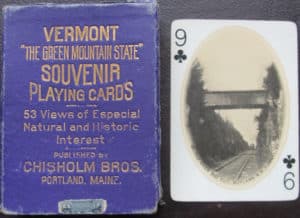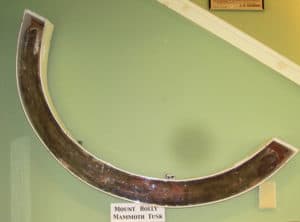
I think most readers know I collect Vermont antiques. Years ago I used to see decks of playing cards with Vermont scenes. Today they are seldom seen. They date to 1910.
Printed on the front of the card box is “Vermont, ‘The Green Mountain State,’ Souvenir Playing Cards, 53 Views of Especial Natural and Historic Interest, Published by Chisolm Bros., Portland, Maine.”
Online I found a little information about the company
“Hugh J. Chisholm was originally a large distributor of printed news materials sold on railroads and steamships throughout the northeast. In 1876 he started a lithographic printing company with his brothers that produced many pictorial tourist guides.
“While their lithographic material was printed in Portland, they imported engraved material in from Germany. At the same time they became heavily invested in Maine’s wood pulp industry. By 1892 they had become an early pioneer in publishing view-cards of the Northeast. Many of their cards were made as heavily retouched photo-chromolithographs.”
This deck of cards is in its original box. Each card is a different Vermont scene. The nine of clubs shown with this article is Summit Cut in Mount Holly.
Summit Cut
From History of Mount Holly, Vermont by Carroll R. Tarbell:
“The Green Mountain Turnpike was the way to the outside world until December 1849 when the Rutland and Burlington Railroad was completed at Summit. On the east side was a rock cut three-quarters of a mile in length and on the west side, a swamp where the bones of a mammoth were found (see Appendix, page 246.)
“The cut was drilled with hand tools, one man sitting and turning the drill and two men alternately striking it with sledges. Black powder was used as dynamite had not been invented. Derricks, probably operated by steam engines, were used. Some places the stone was placed in a semi-circle around where the derrick stood. There are stone piles which would indicate that short lines of tracks were laid away from the cut. Cars were probably drawn by horses and the rock dumped beside the track.”
“Elder Packer in his Journal records, ‘One man killed in 1848.’ Two men were killed on Section 8, and 5 on the Summit in 1849. If eight were killed, a lot more must have been injured, more or less seriously.
“I’ve been told there was a shanty town for the workers and their families which the townspeople called ‘Little Dublin.’ Beaman B. Bixby who lived in the Olney farm didn’t settle with the railroad until October 1852. In the end he accepted $500 for damages.
“Beginning on the north line of land owned by the heirs of Thomas H. Bixby, thence running northerly on the centerline of said Rail Road through the rock cut and including four rods wide on each side of said center line about one-hundred and twenty Eight rods to land of Samuel Hemenway, Jr. And I hereby discharge Rail Road Company from all Claims for damages Sustained by me during and since the Construction of said Road either to my land or water Crops fences, wood and timber and all claims for damages of Every description whatsoever to this date. And I also hereby Convey to said Company the privilege of maintaining and servicing the turn table at the station at Mount Holly Summit. (Vol. 13, page 18).”
In Tarbell’s History of Mount Holly is this photo of the Cut. It’s a postcard with a caption: “Summit Vt. Highway Bridge over Big Cut on line of Rutland R.R.”
Below the photo Tarbell notes, “The bridge was removed in 1919.”
The mammoth

Page 246 as mentioned in part:
“Elephas primogenius Blumenback. It is a remarkable fact, that in making the Rutland and Burlington Railroad, which extends from Burlington to Bellows Falls, two of the most interesting fossils ever found in New England were brought to light. These were the remains of an elephant and a whale. The former were found in Mount Holly, in 1848, the latter in Charlotte, in 1849…
“…In making this excavation, the workman found at the bottom of the bed, resting upon gravel which separated it from the rock below, a huge tooth…Soon afterwards one of the tusks was found…
“…The length of the tusk, measured along the curve on the outer surface, is eighty inches…”
The Mount Holly Historical Society has this tusk on display at their museum in Belmont. Check it out.
This week’s old saying, “I feel more like I do now than I did before.”